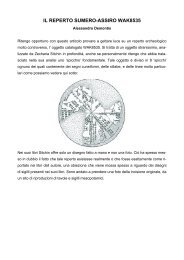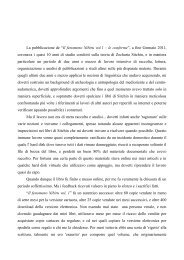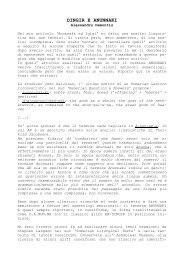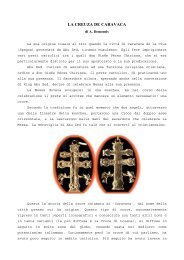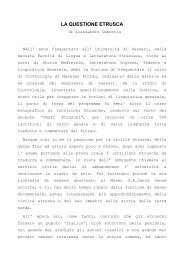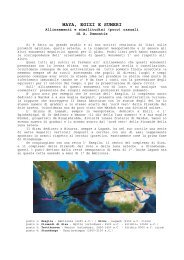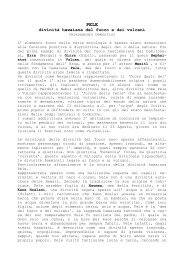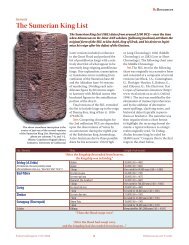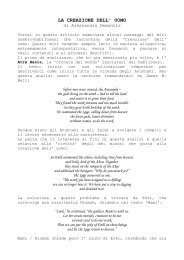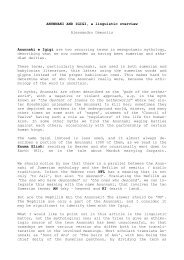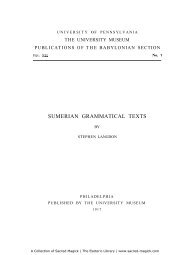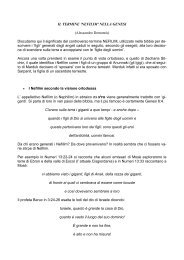LE MOTIVAZIONI DI IAN LAWTON Per comprendere bene il motivo ...
LE MOTIVAZIONI DI IAN LAWTON Per comprendere bene il motivo ...
LE MOTIVAZIONI DI IAN LAWTON Per comprendere bene il motivo ...
You also want an ePaper? Increase the reach of your titles
YUMPU automatically turns print PDFs into web optimized ePapers that Google loves.
La traduzione letterale quindi è “Il NOME/MU sta molto in basso e in alto” o “Il tuo<br />
NOME/MU sta molto dal basso verso l’ alto”. Come si può vedere, a parte <strong>il</strong> significato del<br />
temine MU, Sitchin non fa nessun errore, nessuna modifica, nessuna interpretazione nella<br />
frase. Il significato che riporta è esattamente corrispondente alla versione dell’ ETCSL, e a<br />
quella completata tramite <strong>il</strong> Sumerian Lexicon. Questo è molto importante perché questi<br />
son due strumenti ‘ortodossi’ che provano ancora una volta l’ affidab<strong>il</strong>ità delle traduzioni o<br />
quantomeno dei riferimenti di Sitchin.<br />
Il secondo errore di Lawton in questo caso, come detto, è <strong>il</strong> fare l’ asserzione che si<br />
tratti di un testo dedicato a Ninurta. Questo estratto invece è riferito a Gudea stesso ed è<br />
scritto come se Gudea si riferisse a se stesso. Non solo, in questo passaggio si ‘esalta’ la<br />
figura di Gudea come per beatificarlo per la sua opera di costruzione dell’ Eninnu. Il testo<br />
completo di questo passaggio è:<br />
“Your god, Lord Ninĝišzida, is the grandson of An; your divine mother is Ninsumun,<br />
the bearing mother of good offspring, who loves her offspring; you are a ch<strong>il</strong>d born by the<br />
true cow. You are a true youth made to rise over the land of Lagaš by Ninĝirsu; your name<br />
is established from below to above. Gudea, nobody …… what you say. You are …… a<br />
man known to An. You are a true ruler, for whom the house has determined a good fate.<br />
Gudea, son of Ninĝišzida, you w<strong>il</strong>l enjoy a long life!”<br />
In sostanza anche questa volta Lawton si è dimostrato eccessivamente fallace nella<br />
sua analisi del testo di Sitchin, nell’ affrontare una ricerca identificativa, e nell’ identificare<br />
la corretta natura del testo che esamina; una pecca non da poco per un autore che vanta<br />
anni e anni di ricerca, e soprattutto per un autore che ut<strong>il</strong>izza gli stessi metodi e le stesse<br />
fonti di Sitchin per avvallare la propria teoria.<br />
Il successivo esempio portato da Lawton riguarda <strong>il</strong> mito di Adapa, in cui egli viene<br />
portato in cielo al cospetto di Anu per aver ucciso ‘<strong>il</strong> vento del sud’.<br />
Secondo Lawton:<br />
Sitchin himself does not quote an extract proper,<br />
merely reporting that ‘An demanded to<br />
know who had provided Adapa with a shem<br />
with which to reach the heavenly location’<br />
22



